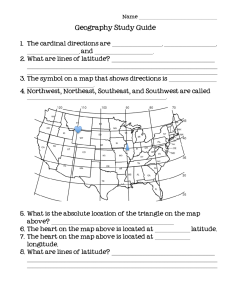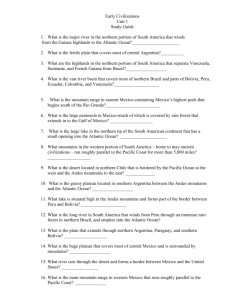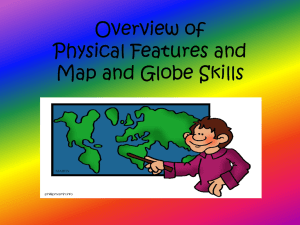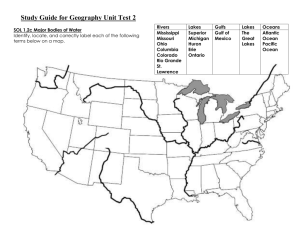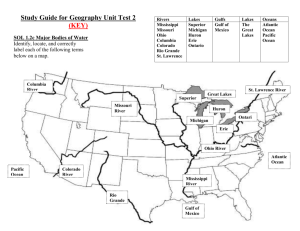LATITUDE
advertisement
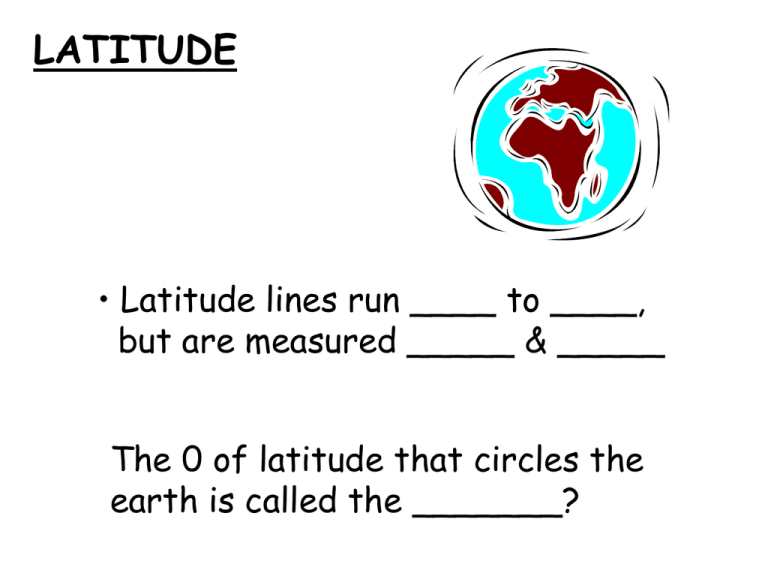
LATITUDE • Latitude lines run ____ to ____, but are measured _____ & _____ The 0 of latitude that circles the earth is called the _______? LATITUDE 0 • Latitude lines run east to west, but are measured north & south The 0 of latitude that circles the earth is called the equator 0 L O N G I T U D E Longitude lines run _____ to _____, but are measured ____ and ____ The 0 line of longitude that extends from the _____ to the_____ Pole is called the _______ _______ L O N G I T U D E 0 0 Longitude lines run north to south, but are measured east and west The 0 line of longitude that extends from the North to the South Pole is called the Prime Meridian KWAKIUTL KWAKIUTL • Northwest/Coastal Range • Rainy but mild climate salmon (food) platform house w/totem pole KWAKIUTL KWAKIUTL fisherman (economy) Canoe transportation SIOUX/LAKOTA SIOUX/LAKOTA • Great Plains • Dry grass land Buffalo (food) Teepee (homes) SIOUX/LAKOTA SIOUX/LAKOTA • nomadic • hunters (economy) Horses (transportation) IROQUOIS IROQUOIS • Eastern Woodland • Appalachian Mtn. • Coastal Plain corn, beans, squash(3 sisters) deer wigwam/longhouse homes IROQUOIS Family subgroup: • • • • • IROQUOIS Family splinter group: • Seneca • Cayuga • Onondaga • Oneida • Mohawks Fur trading (occupation) Foot (transportation) heavily forested 4 seasons INUIT INUIT • • • • Canadian Shield Arctic Circle Alaska & Canada very cold/snow & ice Seal & whale (food) Igloo (homes) INUIT INUIT Hunting/fishing (economy) Kayak & Dogsled (transportation) PUEBLO PUEBLO • • • • Basin & Range southwest New Mexico/Arizona desert-hot/dry Corn=maize (food) pueblo/hogan (homes) PUEBLO PUEBLO Horse (transportation) Herdsmen, traders (economy) AMERICAN INDIANS NATURAL RESOURCES AMERICAN INDIANS NATURAL RESOURCES forest (shelter) ice/water animal/animal skins (food & clothing) fish BERINGIA BERINGIA Land bridge that allowed Asians to follow herds (migrate) into North America COLORADO RIVER COLORADO RIVER • This river was explored by the Spanish & runs through the Grand Canyon RIO GRANDE RIVER RIO GRANDE RIVER • Forms a border with Mexico COLUMBIA RIVER COLUMBIA RIVER • Explored by Lewis & Clark OHIO RIVER OHIO RIVER • Gateway to the west MISSISSIPPI & MISSOURI RIVERS MISSISSIPPI & MISSOURI RIVERS • “The transportation arteries for farm and industrial products. • Links to ports and other parts of the world GULF OF MEXICO Gulf of Mexico GULF OF MEXICO • Provided the French & Spanish with exploration routes to Mexico and parts of America ATLANTIC & PACIFIC 4-LakeOCEANS Michigan 1-Lake Superior 2-Lake Huron 3-Lake Ontario 5-Lake Erie 1 2 3 4 5 Pacific Ocean Atlantic Ocean ATLANTIC & PACIFIC OCEANS • Atlantic Ocean – served as the highway for explorers, early settlers, & later immigrants FACTS TO KNOW: • America’s waterways have been important for trade, transportation and settlement • The location of the United States, with its Atlantic and Pacific Coasts, has provided access to other areas of the world ST. LAWRENCE RIVER St. Lawrence River ST. LAWRENCE RIVER • Forms part of the NORTHEAST border with CANADA and connects the GREAT LAKES to the ATLANTIC OCEAN St. LAWRENCE RIVER CANADA ATLANTIC OCEAN U.S. ST. LAWRENCE & HUDSON RIVERS Lake Huron Lake Superior St. Lawrence RiverLake Ontario Lake Michigan Hudson River Lake Erie GREAT LAKES GREAT LAKES • Inland port cities grew in the Midwest along the Great Lakes COASTAL PLAIN COASTAL PLAIN Location: along the Atlantic Ocean & Gulf of Mexico Physical Characteristics: broad lowland providing many excellent harbors APPALACHIAN MOUNTAINS APPALACHIAN MOUNTAINS Location: west of the Coastal Plain; extends from eastern Canada to western Alabama Physical Characteristics: old eroded mountains—oldest mountain range in North America CANADIAN SHIELD CANADIAN SHIELD Location: wraps around the Hudson Bay in a horseshoe shape Characteristics: worn by erosion & hundreds of lakes carved by glaciers; some of the oldest rock formations in North America INTERIOR LOWLANDS INTERIOR LOWLANDS Location: west of the Appalachian Mountains & east of the Great Plains Characteristics: rolling flatlands with many rivers, broad river valleys, & grassy hills GREAT PLAINS GREAT PLAINS Location: west of the Interior Lowlands & east of the Rocky Mountains Characteristics: flat land that gradually increases in elevation as you go west; it has grasslands ROCKY MOUNTAINS ROCKY MOUNTAINS Location: west of the Great Plains & east of the Basin & Range Characteristics: rugged mountains stretching from Alaska to Mexico with high elevations; contains the Continental Dividewhich determines the flow of rivers BASIN & RANGE ex. of basin BASIN & RANGE Location: west of the Rocky Mtns., east of the Sierra Nevada Mtns., & the Cascade Mtns. Characteristics: an area of different elevations containing isolated mountain ranges and Death Valley, the lowest point in North America COASTAL RANGE COASTAL RANGE Location: rugged mountains located along the Pacific Coast that stretch from California to Canada Characteristics: contains many fertile valleys(land good for growing crops) Name the 7 continents & 5 oceans C A 1 B 3 4 2 E 5 D 7 A 6 Arctic Ocean Pacific Ocean Atlantic Ocean Indian Ocean South Ocean
